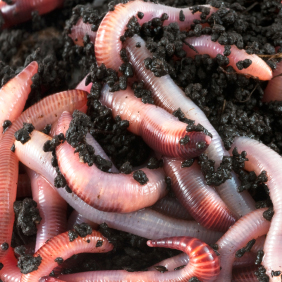Trusted red worms: For compost systems
Get one of the most Out of Your Compost With Red Wigglers
The assimilation of red wigglers into your composting system can significantly boost the efficiency and performance of waste administration techniques. These worms are not just proficient at breaking down organic products but likewise add to the creation of high-grade compost that improves dirt health and wellness.
Understanding Red Wigglers
Understanding red wigglers is necessary for anyone thinking about vermicomposting, as these worms play a pivotal duty in damaging down raw material. Clinically recognized as Eisenia fetida, red wigglers are identified by their reddish-brown color and slim bodies, normally gauging between 3 to 4 inches in size. Unlike earthworms, which prosper in soil, red wigglers prefer a moist, organic-rich setting, making them optimal for composting systems.
These worms are renowned for their ravenous appetite, consuming half their body weight in natural material daily. This capability enables them to quickly decompose kitchen scraps, yard waste, and other eco-friendly materials, changing them right into nutrient-rich garden compost. Red wigglers grow in temperatures varying from 55 ° F to 77 ° F, requiring cautious monitoring of their setting to guarantee ideal activity.
Moreover, red wigglers replicate promptly, increasing their population roughly every 3 to 4 weeks under suitable problems. This quick reproduction is essential for maintaining a reliable composting procedure. red wigglers. Understanding their biology and habits is crucial for anybody seeking to harness their potential in sustainable waste monitoring methods
Benefits of Vermicomposting
Vermicomposting offers various advantages that prolong beyond easy waste reduction. This ingenious approach leverages the natural disintegration capabilities of red wigglers to transform natural waste into nutrient-rich garden compost, enhancing soil health and fertility. The resulting vermicompost is bursting with advantageous microbes, which can enhance dirt structure and boost nutrition accessibility for plants.

Additionally, vermicomposting can be exercised in various setups, making it available for urban residents and those with limited outdoor room. It requires marginal investment and can be easily managed inside your home or outdoors, making it appropriate for various way of livings.
Making use of vermicompost also promotes much healthier plant development by enhancing microbial activity, enhancing water retention, and giving vital nutrients. As a result, gardeners and farmers that integrate vermicompost into their practices usually observe enhanced plant yields, making vermicomposting a lasting choice for both waste management and farming productivity.
Establishing Up Your Worm Bin
Producing an efficient worm container is necessary for effective vermicomposting, and with just a couple of vital components, any individual can develop an efficient system. Start with an appropriate container; a plastic or wood container with a lid works well. Ideally, the container needs to be between 10 to 18 inches deep to provide enough room for the worms to thrive.
Ensure proper air flow by piercing little openings in the sides and lid, permitting air movement while retaining wetness. Preserve a balance in between wetness and drainage; the container ought to perspire but not saturated. A layer of bed linen, such as shredded paper or cardboard, provides a habitat for the worms and aids in moisture retention.
Consider the place of your worm bin (red wigglers). By following these standards, you will certainly produce a helpful setting for red wigglers, laying the groundwork for an effective vermicomposting undertaking.
Feeding Your Red Wigglers

Stay clear of feeding them meat, milk, and oily foods, as these can attract parasites helpful resources and create unpleasant odors. Furthermore, it is crucial to chop or shred larger items to facilitate quicker decomposition, ensuring your worms can access the nutrients extra efficiently.
Small amounts is crucial; overfeeding can cause anaerobic conditions, harming the worms and reducing down the composting process. Screen the container for uneaten food and adjust your feeding program as necessary. A basic guideline is to give about half an extra pound of food per extra pound of worms per week.
Lastly, maintaining moisture is important. Go for a moist, however not soggy, setting, as dampness help in the break down of food and sustains worm task. By carefully managing their diet regimen, you can enhance the effectiveness of your red wigglers in changing organic waste into abundant garden compost.
(red wigglers for sale cheap)
Harvesting and Making Use Of Garden Compost
After numerous weeks of diligent composting, you will observe that the abundant, dark substance produced by your red wigglers is prepared for harvest. One efficient technique is to utilize a light resource; red wigglers are sensitive to light and will certainly delve much deeper right into the product, permitting you to scoop out the leading layer of compost.
Once collected, the compost can be utilized in various applications. Mix it right into yard dirt to improve structure and fertility, or use it as a leading dressing for potted plants. It can likewise be diluted in water to develop a nutrient-rich fluid fertilizer, often called "worm tea." This tea can be applied straight to plants, providing them with an increase of vital nutrients.
Bear in mind to store any kind of unused compost in an amazing, completely dry area to preserve its high quality. By properly collecting and using the compost generated by red wigglers, you not only enrich your yard but additionally promote sustainable horticulture techniques.
Verdict
Integrating red wigglers right into composting techniques substantially improves the effectiveness of organic waste makeover. The application of these worms not just increases the composting procedure yet additionally improves dirt quality through their nutrient-rich spreadings. Establishing a proper worm bin and maintaining ideal conditions makes certain the health and efficiency of these organisms. Ultimately, the integration of red wigglers in composting adds to sustainable gardening, reduces garbage dump waste, and promotes ecological stewardship with effective source recycling.